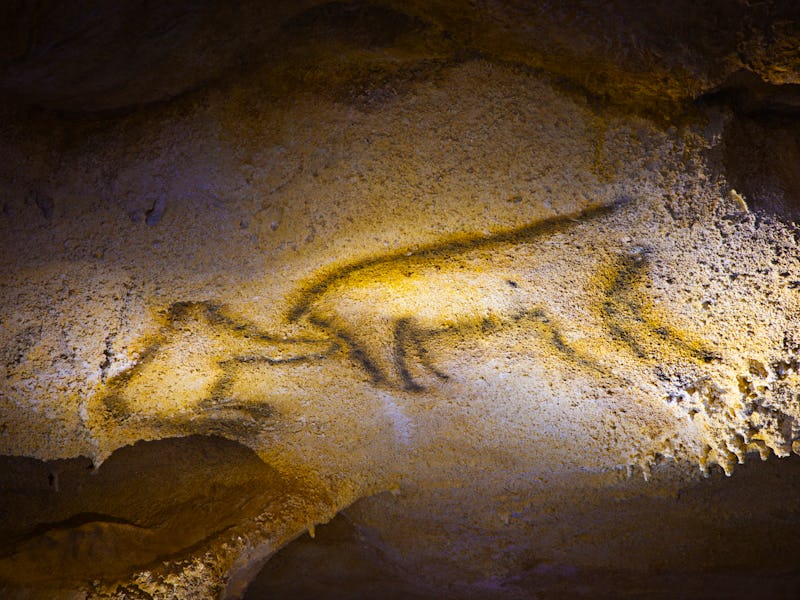Skull scans reveal the tragic end of a prehistoric monster bear
What was a survival adaptation may have eventually spurred these curious creatures' demise.

Even on four legs, ancient cave bears towered over the early humans who encountered them. As recently as 24,000 years ago, these monster bears lurked in limestone caves and possibly even served as muses for humans’ earliest art.
Now, researchers think they know why these massive, curious bears died out.
The answer could settle a debate about what, exactly, the cave bears ate — and how their environment changed their physiology.
While their size may have terrified our early ancestors, scientists speculate that cave bears, Ursus spelaeus, were actually vegetarians. In fact, even cave bears’ ancestors, Deninger’s bears, had similar physical features indicating an herbivorous diet half a million years earlier, according to research published in 2018.
But not all researchers agree about cave bears’ eating habits. The diet debate enters a new phase with the latest research on how adapting to eat more plants fundamentally altered cave bears’ bodies.
A new analysis of cave bear skulls shows that, over time, their physiology changed to have enlarged sinuses.
"Our study proposes that climate cooling probably forced the selection of highly developed sinuses," said study co-author Alejandro Pérez-Ramos, a researcher at the University of Malaga.
"We propose that large sinuses were probably selected in cave bears in order to be able to hibernate for longer periods with very low metabolic costs."
These giant sinuses caused cave bears’ cranial dome to morph, too. The dome grew upward and backward, and as a result, the bears’ skulls weakened — perhaps to the point that simply chewing put a large amount of stress on their bones.
Expanding skulls were a disadvantage for cave bears (left), but prove to benefit sun bears (right).
This was a problem “particularly when biting with the canines or carnassials, the teeth most often used by predatory mammals," Pérez-Ramos said.
Skull morphing can be an advantage, rather than a disadvantage. Sun bears and hyenas, for instance, have undergone similar skull changes that work in their favor. But tragically, this doesn’t seem to have been the case for cave bears.
Instead, this survival adaptation may have actually led to the great animals’ demise. The findings were published in a study Wednesday in the journal Science Advances.
The secret lives of cave bears
By demonstrating how their diet changed cave bears’ skull shape, the new research offers a window into the final days of these massive animals.
Cave bears lived across present-day Europe, with a range that extended into western Russia and into the northern Middle East, according to Prehistoric Wildlife. They were once so abundant that their fossilized remains provided phosphorus for German soldiers during World War I.
The bears, true to their name, spent much of their time hanging out in caves made of limestone, even during summer months, unlike modern bears, which tend to sleep outside when it’s warm.
Essentially, they were habitual hibernators, a trait that researchers now realize made their large sinuses so important.
These were not your average bears.
In their later days, European cave bears coexisted with early humans who settled the continent. Perhaps unsurprisingly, those humans played another big role in the end of the cave bear days. Humans hunted cave bears for meat, fur, and perhaps just because they were big and scary, as National Geographic reports.
An abundance of humans may have also pushed cave bears out of their foraging spaces, making it difficult for them to find enough food, despite their enlarged sinuses helping them smell out their favorite meals.
At the same time, this pressure may have made the cave bears more prone to disease — a problem that only intensifies as species populations’ dwindles.
Sensory overload: How expert noses cause huge problems
Cave bears aren’t the only animal to suffer from a keen sense of smell.
Recent sea turtle research shows a similar pattern at work. Sea turtles’ expert sense of smell helps them find food in the ocean and return to their home nests to lay eggs, a process called “natal homing.” The shelled swimmers take in big gulps of sea water, flooding their nasal cavities and helping them smell.
Unfortunately, that ability also makes them attracted to stinky plastic pollution.
In an recent experiment, sea turtles showed a propensity for “biofouled” plastic, which has gathered the smell of the sea. That makes them likely to be duped, mistaking plastic for food and ingesting it, shows a study published in March in the journal Current Biology.
The sea turtles are an example of an adaptation-turned-hindrance that humans can still do something about. For Europe's cave bears, however, it is sadly thousands of years too late.
Abstract: The cave bear is one of the best known extinct large mammals that inhabited Europe during the “Ice Age,” becoming extinct ≈24,000 years ago along with other members of the Pleistocene megafauna. Long-standing hypotheses speculate that many cave bears died during their long hibernation periods, which were necessary to overcome the severe and prolonged winters of the Last Glacial. Here, we investigate how long hibernation periods in cave bears would have directly affected their feeding biomechanics using CT-based biomechanical simulations of skulls of cave and extant bears. Our results demonstrate that although large paranasal sinuses were necessary for, and consistent with, long hibernation periods, trade-offs in sinus-associated cranial biomechanical traits restricted cave bears to feed exclusively on low energetic vegetal resources during the predormancy period. This biomechanical trade-off constitutes a new key factor to mechanistically explain the demise of this dominant Pleistocene megafaunal species as a direct consequence of climate cooling.